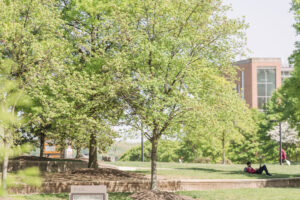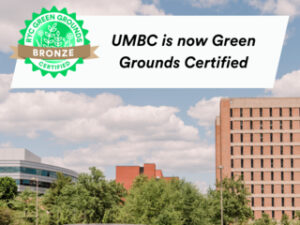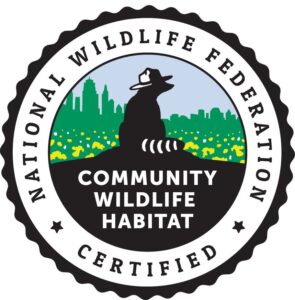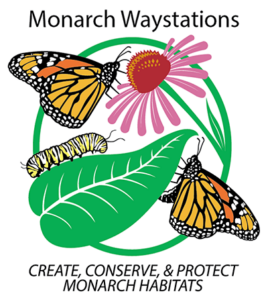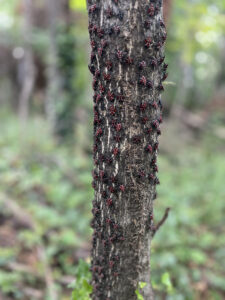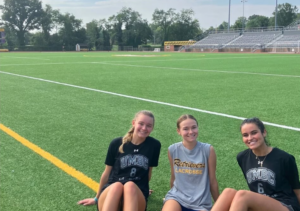UMBC’s Grounds and Landscaping team is making significant strides to incorporate sustainability into their practices and create a campus ecosystem that is safe for local wildlife and people.
Recognized Efforts
As of March of 2024, UMBC’s campus is certified at the Bronze level of Green Grounds certification. awarded by advocacy group Re:wild Your Campus. This new certification recognizes campuses that are eliminating the use of toxic pesticides, increasing organic land care, fostering biodiversity and promoting soil health.
UMBC’s Campus has several Certified Wildlife Habitats, awarded by the National Wildlife Federation, with the most recent being the Center for Well Being pollinator garden. These habitats ensure wildlife are provided with habitat essentials and native plants.
The new pollinator garden at the Center for Well-Being is also certified as a Monarch Waystation, featuring milkweed plants also awarded by the Monarch Watch to create habitat for Monarch butterflies.
Invasive Species and Management
Pictured are spotted examples of invasive species present on campus: spotted lanternfly nymphs.
According to the U.S. Department of the Interior, invasive species are “non-native species whose introduction does or is likely to cause ecological or economic harm, or is a threat to human health.” Invasive species can outcompete native species for natural resources (including water, light, nutrients, and space), disrupt the food chain, draw pollinators away from native plants, have the potential to push rare species closer to extinction, and cause an overall reduction in biodiversity. Biodiversity is necessary for functioning and resilient ecosystems in the face of climate disruption. Invasive species impose substantial costs on society. For example, they can drive native species onto the Endangered Species list, resulting in associated regulatory costs, exacerbate the threat of wildland fire that destroys property and threatens lives, increase the cost of delivering water and power; damage infrastructure, degrade recreation opportunities and discourage tourism.
On UMBC’s campus, there are a significant amount of invasive plant species displacing the native vegetation. These invasive plants continue to add to the stressors facing our natural environment by damaging and altering the native tree population. Not only are invasive species an environmental hazard, but they are a safety hazard. When invasive plants kill trees, these trees can fall onto people, roadways, and property. Through the use and implementation of this management plan, invasive species can be prevented from introduction and spread, removed, managed, and controlled so the associated damages may be significantly reduced.
UMBC’s Invasive Species Management Plan
Stormwater
Only 3% of the Earth’s water can be used as drinking water. UMBC’s stormwater management program helps to protect Maryland’s water resources while allowing UMBC to minimize the impacts to the Chesapeake Bay Watershed. A recently completed hydrologic study provides UMBC with a holistic strategy for managing rainfall run-off originating from campus as well as from upland sources in Catonsville. Best management practices and site improvements that maximize environmental benefit and can be effectively integrated into future campus development were recommended. The study includes specific projects that have the potential to drastically improve how UMBC manages stormwater.
UMBC recognizes the importance of a holistic approach to campus development and sustainability will reinforce the existing natural systems of the campus including our approach to the treatment of stormwater management. The approach is to protect, enhance, and create functional landscapes that demonstrate and celebrate the way water serves as a resource. These landscapes also provide important habitat, microclimate, and aesthetic benefits that will be consistent with their specific locations on campus. Through a combination of forest preservation, stream rehabilitation, landscape conversions, and progressive water management solutions, like the creation of wetlands, the campus moves closer to a level of ecological balance. Each redevelopment and new development of quadrangles, courtyards, plazas, and walkways will target opportunities to incorporate working landscapes that enhance ecology and water management. Proposed ecological transformations to improve campus stormwater management and open space include:
- Extension of an existing stream bed into a new 10-acre wetland, enhancing stormwater treatment, habitat, and ecological function of the south of the campus within an existing low-lying stream buffer
- Improvements to the Central Green to improve the integration of stormwater management into existing outdoor spaces to control erosion, improve drainage, and enhance functionality
- Transformation of existing mowed grass areas, especially on steep slopes, into working native landscapes, to support pollinators and improve local water quality
- Growth of forest conservation areas that will preserve existing wooded areas and protect our stream valleys
What is stormwater?
 The Baltimore area, on average, receives 42 inches of precipitation per year. When it rains, or snow melts, where does it all go? In natural areas, the fallen precipitation is able to quickly infiltrate, or soak through, into the ground (~18 in/hr). On maintained areas, like lawns, the infiltration into the ground takes much longer (~2 in/hr). However, all the water that cannot infiltrate hard surfaces like roofs, sidewalks, and roads flows into a storm drain and into the nearest waterway – that water is called stormwater. Often times stormwater is discharged directly into lakes, fivers, streams, or the Bay without ever being cleaned or filtered. This means that stormwater can pick up debris and pollutants off the streets or sidewalks and bring those materials directly into the bodies of water where we get our drinking water from and recreate in and around. Visit MDE to learn more about stormwater.
The Baltimore area, on average, receives 42 inches of precipitation per year. When it rains, or snow melts, where does it all go? In natural areas, the fallen precipitation is able to quickly infiltrate, or soak through, into the ground (~18 in/hr). On maintained areas, like lawns, the infiltration into the ground takes much longer (~2 in/hr). However, all the water that cannot infiltrate hard surfaces like roofs, sidewalks, and roads flows into a storm drain and into the nearest waterway – that water is called stormwater. Often times stormwater is discharged directly into lakes, fivers, streams, or the Bay without ever being cleaned or filtered. This means that stormwater can pick up debris and pollutants off the streets or sidewalks and bring those materials directly into the bodies of water where we get our drinking water from and recreate in and around. Visit MDE to learn more about stormwater.
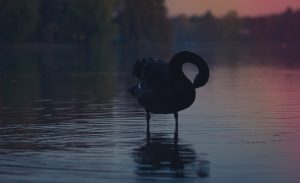
Where does stormwater go?
At UMBC stormwater ultimately flows into the Patapsco River and into the Chesapeake Bay. This is why it is so important to ensure that only rain goes down a storm drain!
How does UMBC manage stormwater?
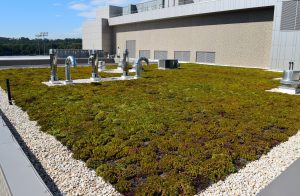 At UMBC, stormwater is well managed to control flooding, reduce erosion, and improve water quality. UMBC has installed over 90 best management practices (BMPs) across campus. BMPs are structural, vegetative, or managerial practices used to treat, prevent, or reduce water pollution. Some of the BMPs are highly visible, like the several green roofs on campus; whereas, other BMPs are designed invisibly blend in like permeable pavement.
At UMBC, stormwater is well managed to control flooding, reduce erosion, and improve water quality. UMBC has installed over 90 best management practices (BMPs) across campus. BMPs are structural, vegetative, or managerial practices used to treat, prevent, or reduce water pollution. Some of the BMPs are highly visible, like the several green roofs on campus; whereas, other BMPs are designed invisibly blend in like permeable pavement.
The Garden
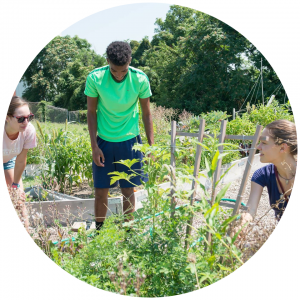 UMBC is home to a student-led community garden that is open to all members of the UMBC Community. The community garden is located by the UMBC Police Station and the Food Forest. “The Garden”, a student organization, describes the mission of the garden as “seeking to re-imagine the role of higher education in addressing problems of the world through the creation and engagement of our food garden that enables creativity in research, applied learning, campus-community partnerships, pedagogy, social equity, diversity, and food sovereignty.”
UMBC is home to a student-led community garden that is open to all members of the UMBC Community. The community garden is located by the UMBC Police Station and the Food Forest. “The Garden”, a student organization, describes the mission of the garden as “seeking to re-imagine the role of higher education in addressing problems of the world through the creation and engagement of our food garden that enables creativity in research, applied learning, campus-community partnerships, pedagogy, social equity, diversity, and food sovereignty.”
The Garden is responsible for the maintenance of the physical community garden and for the allocation of plots to campus groups/individuals. The group also provides plot recipients with an orientation to learn how to grow in their section of the garden’s raised beds. The groups choose what to grow and do with the food they grow in their plot. The garden also provides a tool-share, garden-related composting, fun events, and community workdays.
Trails on Campus
The Conservation and Environmental Research Area (CERA) is a 50 acre protected natural area on campus established in 1997 thanks to the efforts of Dr. Eugene ‘Sandy’ Parker, Chair of the Geography & Environmental Systems (GES) Department. When plans to expand the campus through the development of a research park arose, the campus carefully set aside space to remain forested in response to concerns on the environmental impacts of the development. The Landscape Stewardship Committee was created to ensure the campus has a say in managing open space and the land on campus in an ecologically responsible manner. The committee was established at the request of faculty, who along with students, played a major role in advocating for the environment as a priority in campus planning.
CERA is frequently used as a living lab for professors and students supporting both classroom-based and independent research projects. In SCI 100 over 700 students annually study the science of water. GES 220 students learn field techniques and use their new skills to develop their own projects. GES 286 introduces students to the world of satellite imagery and GPS technology. UMBC students are given the unique opportunity and support to conduct independent student research as well as faculty research on the campus itself.
The larger tract of CERA, covering approximately 45 acres of the south end of the main campus, is composed of a wide variety of ecological conditions: mature upland forest, early- and mid- successional forest, and riparian and wetland environments. The second, and much smaller CERA area (~3 acres), surrounds CERA Pond. In addition to teaching opportunities for faculty, CERA offers a wide range of opportunities for students and faculty to undertake short and long-term research projects in a variety of disciplines. Management of CERA is guided by the need to maintain these landscapes as natural areas to be preserved and protected for approved uses in education, research, and wildlife observation.
The Herbert Run Greenway is a 1.4 mile loop connecting several natural spaces on the UMBC campus. As you spend time on the HRG, you will encounter historic trees that predate the American Revolution, a sculpture garden inspired by the work of Joseph Beuys, an upland forest teeming with wildlife, and much more.
Here is the official new trail map for the HRG now that the construction of the event center is complete:
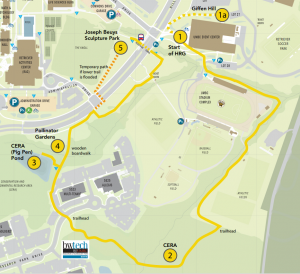
For trail maintenance and service requests please visit: fm.umbc.edu/work-request/
Sustainable Turf at Retriever Soccer Park
Replaced in 2024, The field’s fill is made from sustainably harvested Loblolly Pine, making it free of added PFAS which are harmful to the health of both our athletes and our planet, as compared to other artificial turf products.
BrockFill is also Cradle2Cradle certified, and is Gold Level for Product Circularity!
